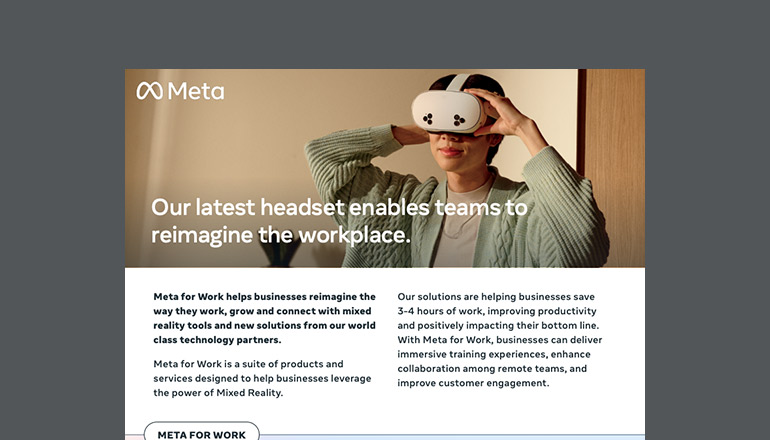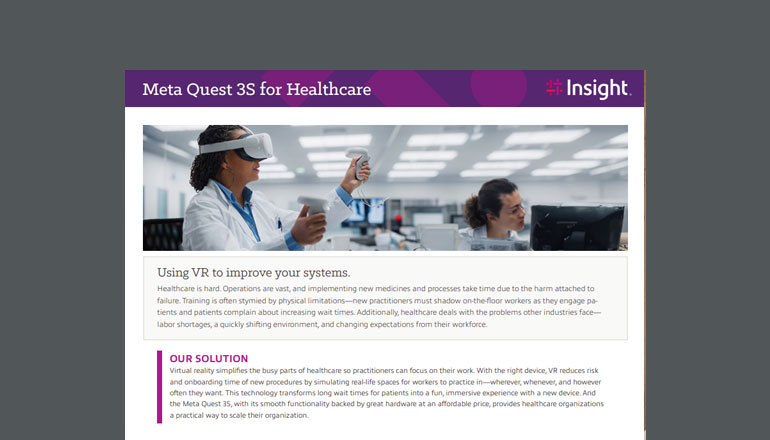Partner Voices Blend the Digital and Physical With Meta Quest
By Insight Editor / 21 Sep 2022 / Topics: Devices Virtual Reality (VR)

Immerse yourself in the future of work with Meta Quest. You’ll be present with your teams in ways you never imagined and expand what’s possible at work.
When it comes to creating seamless, business-enabling simulations in a risk free, true-to-life and cost-effective way, VR is almost peerless. Its massive scalability, capacity for personalization and ability to provide not only high-level work role guidance, but also step-by-step technical facilitation, are accelerating VR’s rise as an invaluable tool across healthcare, manufacturing, retail, financial services and a host of other industries. Moreover, with a record number of workers now operating remotely, it is opening the doors to new, more effective approaches to training and daily work at a distance.
Working with Meta Quest 2 provides powerful new ways to make your business smarter, faster and more productive:
- Collaboration: You’ll unlock new opportunities for creative brainstorming and faster prototyping. Features like 3D sketching, real-time rendering and object manipulation help designers and manufacturers deliver breakthrough innovations.
- Learning: From practicing new surgical techniques to spending a day in the shoes of front-line workers, VR can create scalable, immersive learning experiences that are safer, more engaging and more cost-effective than in-person training.
- Productivity: Working in VR gives you more space to focus with fewer distractions. You’ll crush your to-do lists with multiple screens and apps running side by side, and customize your environment — or even yourself — so that you’re empowered to do your best work.
Myriad ways to connect and learn
While the high-level applications of VR have been touted for some time — real-time collaboration, the ability to practice dangerous tasks safely, and new opportunities to build soft skills among them — a plethora of emerging real-life use cases are beginning to open industry leaders’ eyes still further to the opportunities that await.
Healthcare
Healthcare and medical research are both industries particularly ripe for VR technology. Recently, we’ve seen the emergence of not only immersive VR surgical training tools but also molecular modeling applications, enabling medicinal chemists to physically interact with molecular structures in the quest to design new breakthrough medicines. Pediatric trauma training, dissections and detailed interior visualizations of the human anatomy are yet more VR applications opening up new vistas for more effective, intelligent care.
Built environment & construction
Other industries are no less affected. Consider construction. New VR capabilities enable construction workers to safely train on new potentially hazardous machinery in total safety, and building designers and construction professionals can now walk through 3D models of projects together to identify issues and come up with solutions. And, if project teams are separated by distance — as is often the case on cutting-edge designs requiring international specialists — experts can now meet and collaborate naturally in virtual project rooms, even being represented by photorealistic avatars if they choose to.
Retail
Retailers, insurers and a host of other service-oriented businesses are also benefiting from VR.
Not only does VR offer internal staff lifelike in-person interaction for key meetings, whiteboarding and brainstorming, but companies’ partners and customers are benefiting too. An example: the ability to offer factory or store walk-throughs and plan shelf displays with far greater detail and aesthetic nuance. Retailers enjoy a particularly vast array of VR applications, including heat-mapping technology which tracks shoppers’ gazes in store, providing detailed insight into which areas or products are attracting attention.
Cross-industry applications
Of course, the “soft skills” of leadership and people management necessary in every industry are not excluded from the many applications of VR. Recruiting, onboarding, retention, sales staff training and customer-facing experiences can all be facilitated in an engaging lifelike way that lessens the burden on HR and other training staff. Moreover, staff can be trained to cope with events that are not everyday occurrences, such as Black Friday crowds, emergency situations and more.
While currently fewer than a million jobs are impacted by VR and AR, the technologies’ use is forecast to rise steeply in the coming years — to a total of 23 million jobs by 2030, according to PWC.¹








